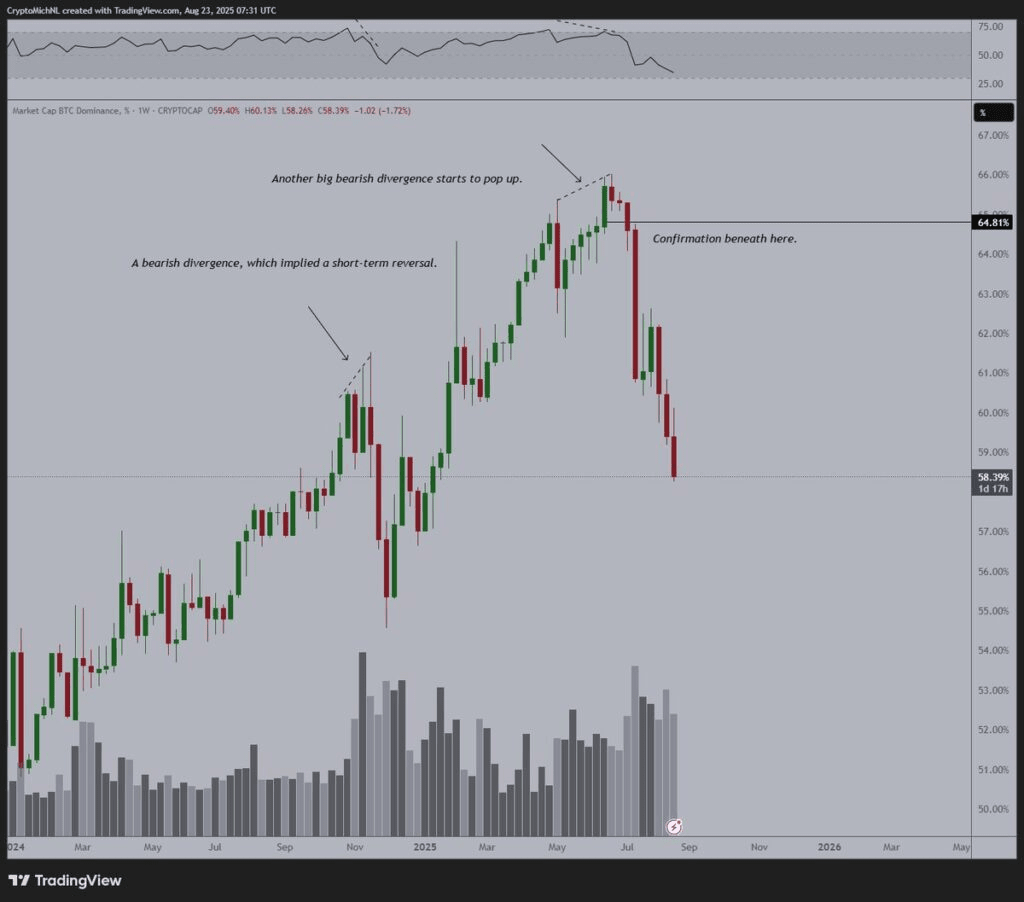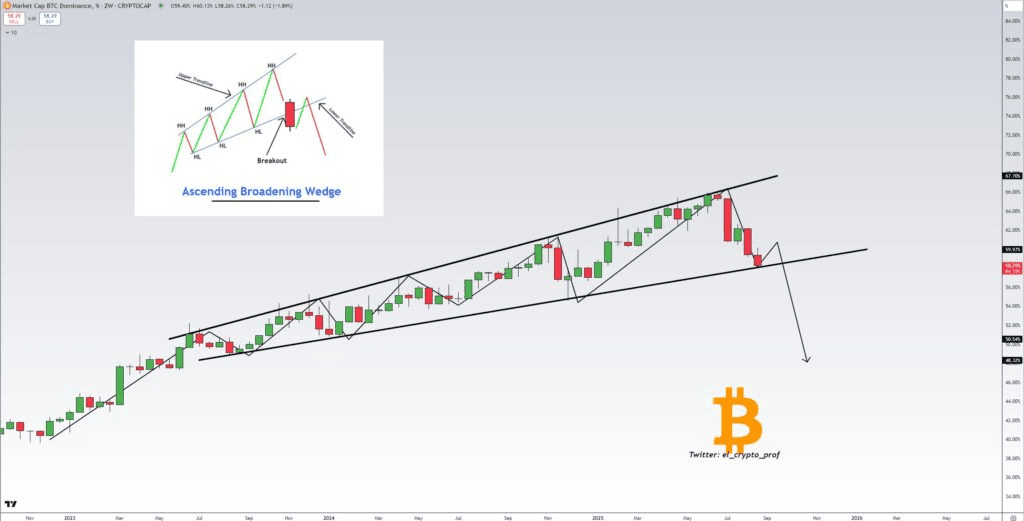Bitcoin's dominance has fallen from about 66% to around 58%, indicating that capital is rotating into Ethereum and altcoins; if the current sell-off continues, technical signals—RSI divergence and wedge breakout—point to further downward targets, approaching 50.56% and 48.32%.
Bitcoin's dominance has fallen below the critical support level of 64.81%, confirming that Bitcoin's market share is weakening.
Ethereum has reclaimed its historical high, supporting altcoin momentum and broader market rotation.
Analysts have identified a wedge pattern, with downward targets of 50.56% and 48.32% if the decline continues.
Due to RSI divergence and wedge breakout, Bitcoin's dominance has dropped to around 58%; understanding market impacts and what traders should focus on next. Start positioning immediately.
What causes the recent decline in Bitcoin's dominance?
Bitcoin's dominance has sharply declined after breaking through key resistance levels, falling from nearly 66% to around 58.39%. Technical factors—bearish divergence in RSI and confirmation of a drop below the 64.81% support level—combined with funds flowing back into Ethereum and altcoins, have led to a rapid decline in Bitcoin's market share.
How does Ethereum's historical high affect market rotation?
Ethereum's return to historical highs is an important signal indicating that funds are shifting from Bitcoin to smart contract tokens. Analysts, including Michael van de Poppe (plain text source), report that its dominance has decreased by about 8% and expect altcoins to follow Ethereum's momentum in the coming weeks. Short-term volatility may pause this rotation, but structural trends favor altcoins as dominance remains below the breakout support level.
Key support level breakdown
Dominance has risen from less than 50% at the beginning of 2024 to nearly 66% by mid-2025, reflecting the high concentration of capital in Bitcoin. When the Relative Strength Index (RSI) shows lower highs while dominance shows higher highs, this trend reverses—this is a classic bearish divergence indicating waning momentum.

As dominance falls below the 64.81% support level, selling accelerates and bearish volume increases. The current reading near 58.39% represents a significant retracement from recent highs, with RSI breaking below the midpoint, reinforcing the loss of confidence in buying Bitcoin's market share.
What does the wedge pattern mean for future dominance levels?
Over a two-week timeframe, analysts including El Crypto Prof (plain text source) have identified an ascending expanding wedge spanning over two years. This pattern features continuously rising highs and lows, with trendline divergence, which often signals increased volatility and trend exhaustion.

Dominance is testing the lower boundary of the wedge (near 59.97%). A decisive breakdown will open up the downward targets of 50.56% and 48.32% as predicted by analysts. Conversely, a rebound could trigger a retest of the 62-64% area, although this scenario would require a resurgence in buying volume favorable to Bitcoin.
How do altcoins respond to the shift in dominance?
Early signs indicate that as investors reallocate funds to Ethereum and selectively to Layer-1 and DeFi tokens, altcoins' market share is steadily growing. Trading activity, on-chain fund flows, and renewed rallies in specific tokens are supporting the market's transition from Bitcoin dominance to broader participation.
What technical indicators suggest Bitcoin's dominance?
RSI divergence and a drop below the 64.81% support level suggest that Bitcoin's dominance momentum is weakening. Analysts point out that if the decline persists, bearish volume will increase, intensifying the wedge pattern risk, with declines potentially extending to 50.56% and 48.32%.
Should traders now turn to altcoins?
Traders should consider position size and risk tolerance; market rotation favors altcoins, but volatility remains high. Before increasing altcoin positions, use stop-loss management and monitor dominance levels, RSI, and trading volume for confirmation.
Key points
Support level breached: Bitcoin's dominance has fallen below 64.81%, confirming a bearish shift.
Altcoin rotation: Ethereum's historical new high strengthens the case for altcoins gaining market share.
Operational targets: If the wedge breakout continues, analysts have marked 50.56% and 48.32% as downward targets.
Conclusion
Bitcoin's dominance suggests a significant shift in market breadth: falling below 64.81% and the RSI divergence has allowed Ethereum and other altcoins to regain upward momentum. As the market enters the next phase, traders should watch dominance levels, on-chain fund flows, and trading volume to confirm market trends and manage risks.

